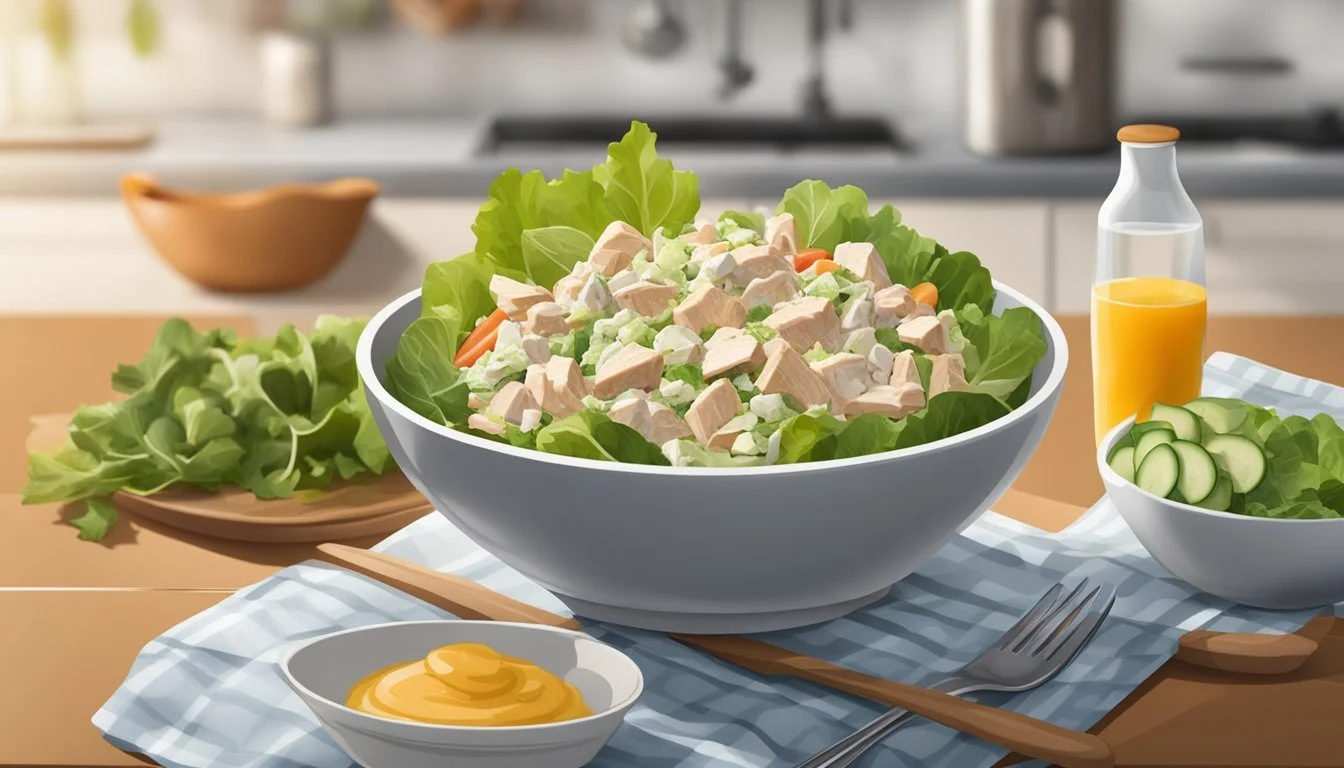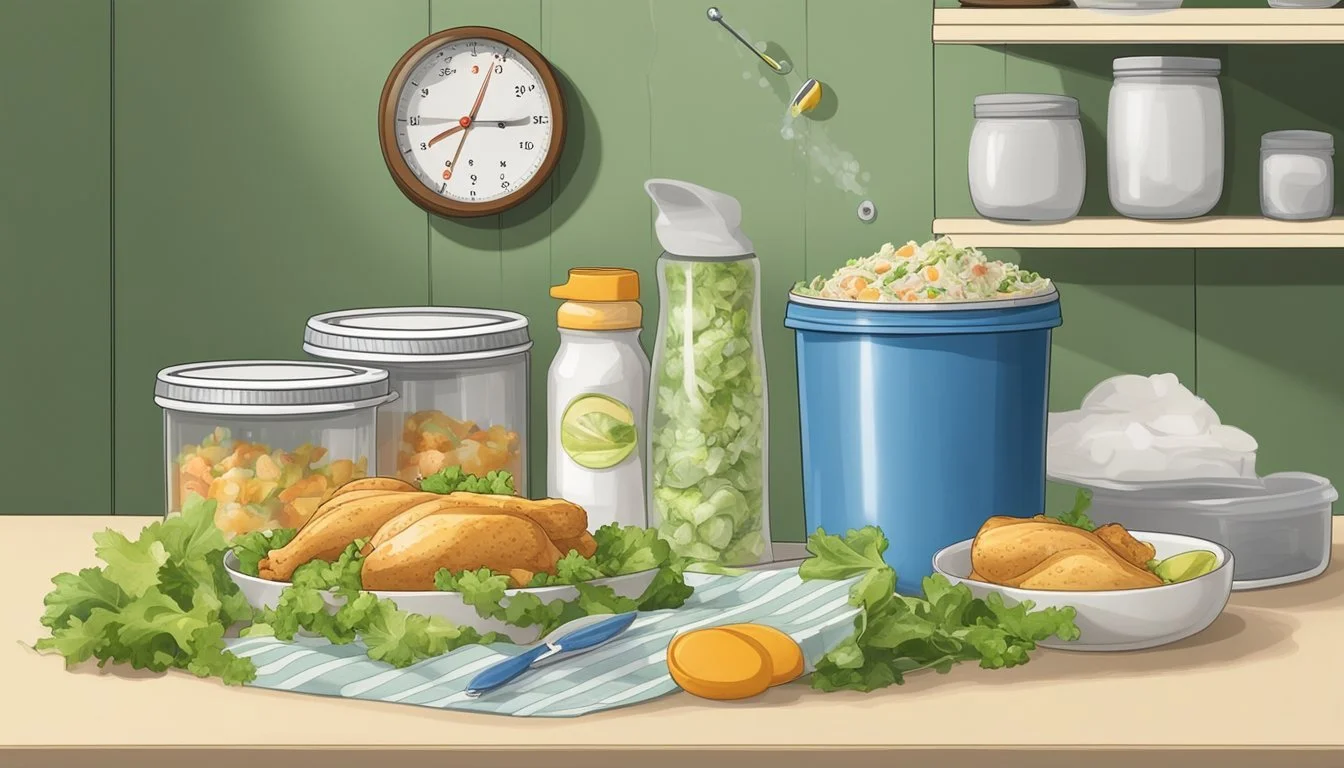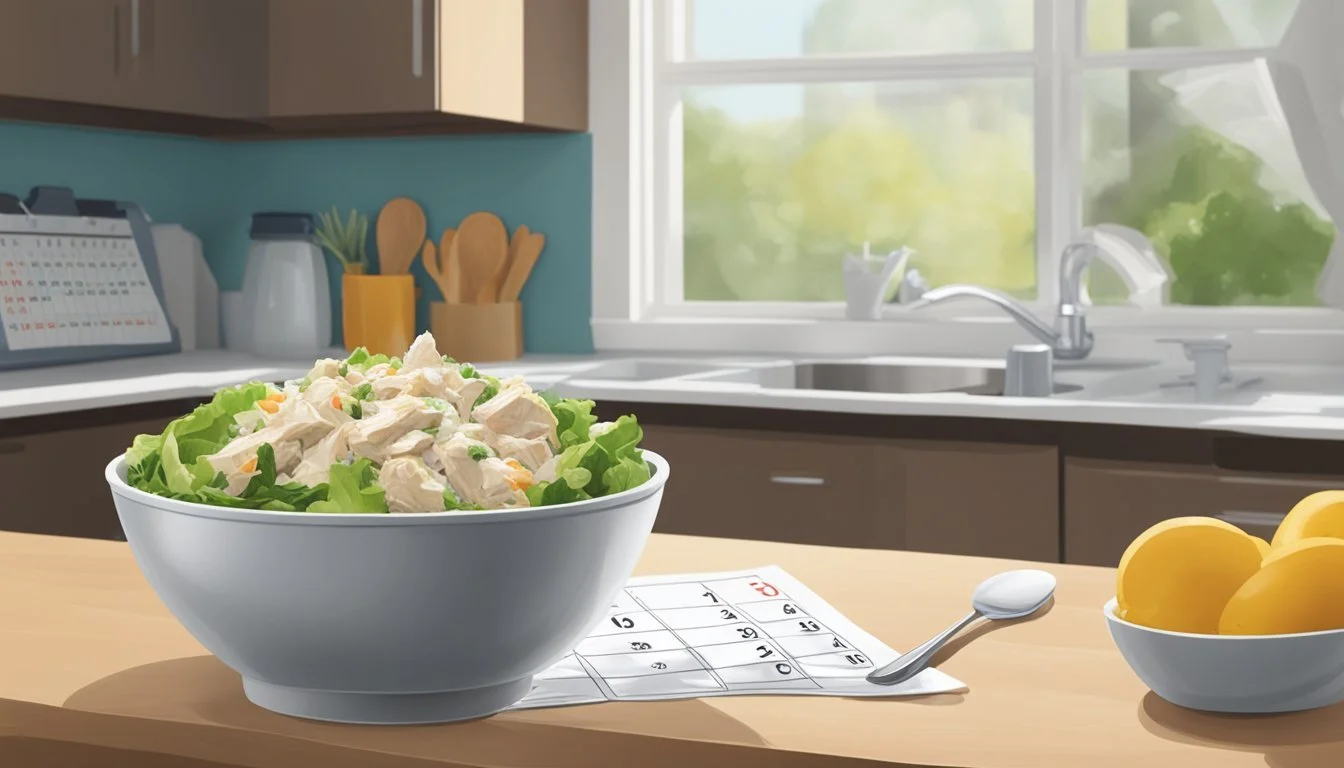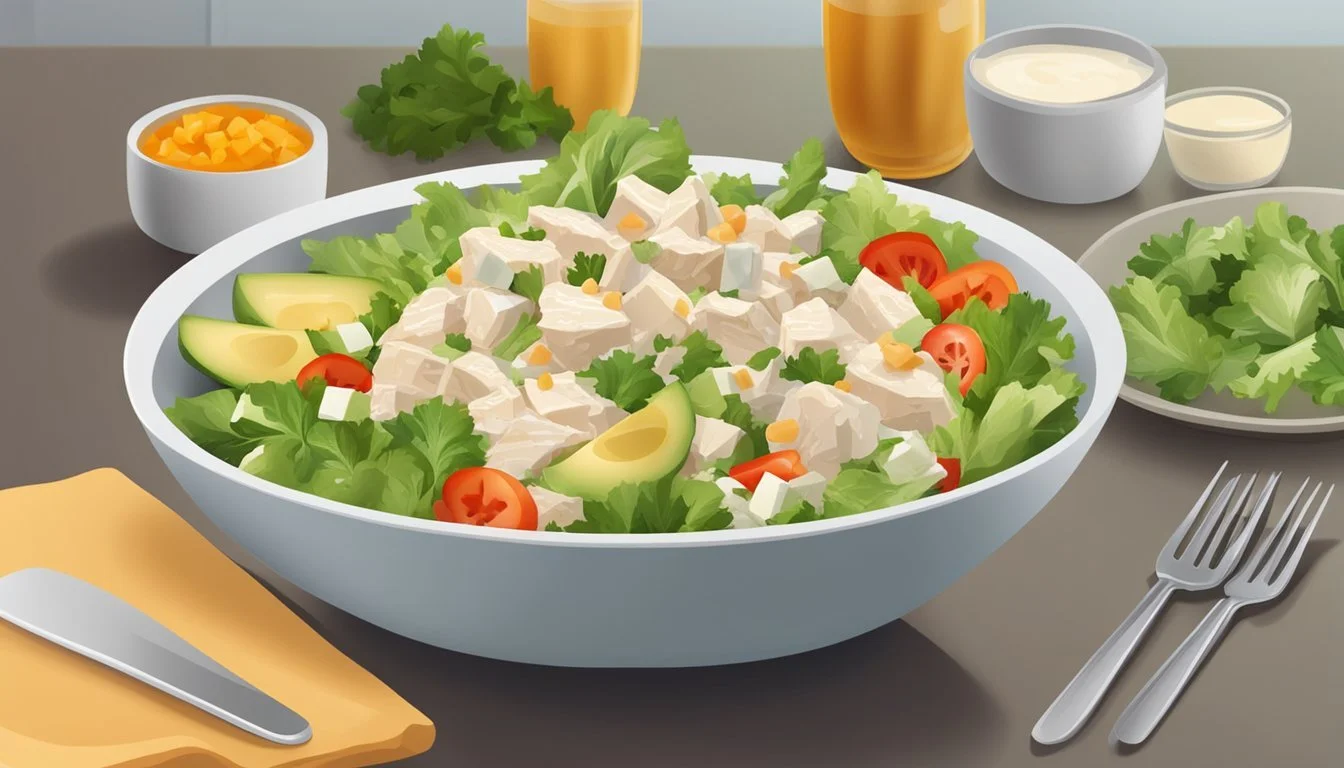How Long Does Freshly Prepared Chicken Salad Last?
Shelf Life Explained
When it comes to the shelf life of freshly prepared chicken salad, food safety and quality are primary concerns. The lifespan of this popular dish in the refrigerator, when stored properly, is typically between three to five days. This duration complies with the recommendations set forth by food safety authorities, such as the U.S. Department of Agriculture and FoodSafety.gov, who suggest using cooked chicken—which is the primary ingredient in chicken salad—within this timeframe to maintain its freshness and safety for consumption.
The shelf life of chicken salad also heavily depends on the ingredients it contains and the way it is stored. Ingredients like mayonnaise, a common component, can influence how long the salad remains fresh. To maximize the salad's shelf life, it should be kept in an airtight container and refrigerated consistently at or below 40°F. The consistent temperature minimizes the risk of bacterial growth, a crucial factor in preserving food safety and maintaining the quality of the chicken salad.
Homemade chicken salad, having no preservatives compared to store-bought varieties, adheres to the same storage principles for ensuring maximum freshness. It's essential for consumers to observe these storage guidelines carefully to enjoy their chicken salad in its best state, both in flavor and from a health standpoint.
Optimal Storage Conditions for Chicken Salad
Proper storage is critical for maintaining the quality and safety of chicken salad. It strongly influences its shelf life and freshness.
Refrigeration and Temperature Control
Temperature is a crucial factor in preserving chicken salad. To inhibit bacterial growth, chicken salad should be stored in the refrigerator at a steady temperature of 40°F (4°C) or below. It is recommended to consume the salad within 3-4 days of preparation. Exceeding this timeframe can compromise food safety and quality. Any temperature above 40°F can promote bacterial growth, increasing the risk of foodborne illness.
Airtight Containers and Moisture Content
Storing chicken salad in an airtight container is essential to maintain freshness and prevent contamination. The container limits exposure to air, which can contain pathogens and moisture that may accelerate spoilage. An airtight container also helps to regulate moisture content, which is important for both texture and flavor preservation. A container with a good seal prevents additional moisture from getting in, which could make the salad soggy, and keeps the existing moisture from getting out, preventing dryness.
Factors Affecting Chicken Salad's Freshness
The shelf-life of chicken salad is notably influenced by its components and mode of preparation. Key elements such as ingredients' freshness, mayonnaise consistency, and storage methods play crucial roles in determining freshness duration.
Ingredients and Their Impact
Chicken salad's freshness can be affected by the quality and type of ingredients used. Fresh ingredients like herbs and vegetables will usually last shorter than the cooked chicken itself. It's imperative to use fresh, high-quality ingredients to maximize the salad's freshness. Here's a brief outline:
Cooked Chicken: Lasts 3-4 days when refrigerated properly.
Vegetables: Cut vegetables can introduce moisture, which may shorten shelf-life.
Fresh Ingredients: The addition of any new, moist foods should be done close to serving.
Role of Mayonnaise and Creamy Elements
Mayonnaise and other creamy elements in chicken salad bind the ingredients together and can influence both flavor and texture. When these elements are oil-based, they tend to act as a barrier, slowing down the process of spoilage. However, these dressings can separate and spoil, adversely affecting freshness:
Mayonnaise: Must be kept cold to prevent spoilage and maintain texture.
Oil Content: Higher oil content can help in preservation, but doesn't replace proper refrigeration.
Preparing for Prolonged Freshness
The longevity of chicken salad's freshness is also determined by how it is prepared and stored. Immediate refrigeration in an airtight container is essential. Keeping the salad at or below 40°F (4°C) is critical to mitigate bacterial growth. Here are key strategies to ensure prolonged freshness:
Airtight Containers: Minimize air exposure to reduce deterioration.
Temperature: Consistently cold temperatures are crucial for food safety.
Serving Tips: Add high moisture ingredients just before serving to extend freshness.
Shelf Life and Spoilage Indicators
Freshly prepared chicken salad's viability heavily depends on proper storage and attentive handling to ensure food safety. This section details the expected shelf life, how to detect spoilage, and adheres to food safety guidelines.
Understanding Shelf Life
The shelf life of chicken salad is generally 3 to 5 days when stored in the refrigerator at or below 40°F in an airtight container. Key contributors to this timeline include the freshness of the chicken and other ingredients at the time of preparation, as well as the temperature at which the salad is stored. The United States Department of Agriculture (USDA) reinforces the importance of refrigeration to inhibit bacterial growth that can lead to spoilage.
Detecting Spoilage Through Senses
To determine if chicken salad has spoiled, one should trust their senses. Here are specific indicators:
Smell: A sour or off-putting aroma is a clear sign of spoilage.
Appearance: Any signs of mold or an unusual color change signal that the salad has gone bad.
Texture: A slimy or unusually sticky texture is indicative of spoiled chicken salad.
If any of these indicators are present, the salad should be discarded to avoid the risk of foodborne illness.
Expiration Date and Food Safety Guidelines
While homemade chicken salad does not come with an expiration date, following food safety guidelines can help prevent foodborne illnesses. The USDA recommends consuming prepared chicken salad within three to four days of preparation. It's crucial to adhere to these guidelines and maintain a refrigerator temperature of 40°F or below to ensure the chicken salad remains within safe consumption parameters. If ever in doubt, it is safer to discard the salad rather than risk the potential for food poisoning.
Health and Safety Considerations
When it comes to freshly prepared chicken salad, ensuring safety and preventing foodborne illnesses are paramount. Proper handling and storage are the key factors to minimize risks and maintain the salad's quality.
Preventing Foodborne Illnesses
The risk of foodborne illnesses, particularly from bacteria such as Salmonella, can be mitigated by adhering to strict temperature control. Freshly prepared chicken salad should be kept at or below 40°F (4°C) to slow bacterial growth. It is advised to consume chicken salad within 3 to 5 days of preparation when stored correctly in the refrigerator. When serving, chicken salad should not be left at room temperature for more than 2 hours, or 1 hour if the ambient temperature exceeds 90°F.
Cross-Contamination Risks
Cross-contamination is the transfer of harmful bacteria from one food item to another. This can occur when handling raw poultry and then touching the salad without properly washing hands or using clean utensils. To prevent cross-contamination:
Always wash hands with warm, soapy water for at least 20 seconds before and after handling chicken.
Use separate cutting boards and utensils for raw chicken and other salad ingredients.
Ensure that any surface or container used for raw poultry is thoroughly cleaned before being used for the salad.
Store the chicken salad in airtight containers to keep out harmful bacteria and maintain freshness.
Strategies for Extending Chicken Salad's Edibility
To maintain the quality and safety of chicken salad, one must implement effective storage strategies. These can notably prolong the edibility window of the dish.
Freezing and Thawing Techniques
Chicken Salad: It's generally not recommended to freeze a prepared chicken salad, especially if it contains mayonnaise or other dairy-based dressings, as they can separate and become unpalatable upon thawing.
Cooked Chicken: For the chicken component, one can freeze cooked chicken pieces before combining them into salad. Freeze in an airtight container or heavy-duty freezer bags.
Thawing:
Refrigerator Thawing: Transfer the frozen chicken to the refrigerator, allowing it to thaw slowly and safely.
Cold Water Thawing: Seal the chicken in a plastic bag and submerge it in cold water, changing the water every 30 minutes.
Alternative Preservation Methods
Temperature Control:
Storage Temperature: Always store chicken salad at a temperature below 40°F to inhibit bacterial growth.
Individual Ingredients: Store each component separately to extend freshness. Combine them just before serving.
Airtight Containers:
Utilize airtight containers for storage to reduce exposure to air and prevent contamination.
Ingredient Selection:
Select fresh, high-quality ingredients and prepare the chicken salad in a clean, sanitized environment to ensure maximum shelf life.
Understanding Chicken Salad Variations
Chicken salad's shelf life can be influenced by its origin—whether it's homemade or purchased from a store—and the specific recipe used to make it. Each variation brings different factors that can affect its freshness duration.
Homemade vs. Store-Bought Differences
Homemade chicken salad typically comes with a fresher taste but a shorter shelf life due to the lack of preservatives. In contrast, store-bought chicken salad often contains preservatives that extend its longevity.
Homemade chicken salad:
Fresher ingredients
No preservatives
Lasts 3-4 days when refrigerated at 40°F or below
Store-bought chicken salad:
Longer shelf life due to preservatives
Consistent flavor profile
Can last 3-5 days under proper refrigeration
Adapting Recipes for Optimal Shelf Life
Optimizing a chicken salad recipe for shelf life involves careful selection of ingredients and storage methods. Certain ingredients can shorten or extend the salad's freshness.
To extend shelf life:
Use fresh, high-quality chicken and vegetables
Avoid or minimize high moisture ingredients like fruits and certain vegetables until serving
Store in an airtight container
Factors reducing shelf life:
Addition of dressings or mayonnaise that separate or spoil faster
Incorporation of ingredients that can quickly degrade, like chopped tomatoes or cucumbers
By considering these factors, one can make informed choices about preparing and storing chicken salads (What wine goes well with salads?) to maximize their freshness.
Practical Usage Tips for Chicken Salad
When preparing and using chicken salad, maintaining freshness and flavor is crucial. These tips will ensure one's chicken salad remains a crowd-pleaser at social gatherings and a tasty staple for personal lunch (What wine goes well with lunch?) options.
Serving Chicken Salad at Events
For events like potlucks or picnics, keeping chicken salad cool is pivotal. One should serve it in a bowl nested within a larger ice-filled bowl to maintain a temperature below 40°F. This not only prevents bacterial growth but also keeps the salad delicious. Additionally, incorporating a variety of herbs and spices can elevate the flavor, satisfying a diverse palate without compromising the salad's integrity.
Creative Lunch Ideas
Chicken salad can be a versatile component in lunchtime favorites. For a chicken salad sandwich, one should use shredded chicken mixed with creamy mayonnaise or Greek yogurt, and spices like Dijon mustard for added zest. It's an excellent way to utilize leftovers while keeping lunchtime both interesting and healthful. One can also pair the salad with different salad ingredients to construct a balanced meal or present it as a snack in lettuce wraps for a low-carb option.
Safe Reheating and Consumption
When it comes to freshly prepared chicken salad, ensuring that leftovers are reheated and consumed safely can prevent foodborne illness and maintain the quality of the dish.
Ensuring Quality and Safety Upon Reheating
Properly reheating chicken salad leftovers involves more than just warming them up. One should be attentive to not only safety but also to the quality of the salad components.
Temperature Range: Leftovers must be reheated to an internal temperature of 165°F to ensure safety. Always use a thermometer to check the temperature.
Moisture Retention: Reheating can sometimes cause the salad to become watery. To mitigate this, one might want to drain excess moisture, if possible, before reheating.
Celery and Miracle Whip: These ingredients can change texture upon reheating. Celery may become soft, and Miracle Whip could separate due to its moisture content; therefore, reheating these ingredients is generally not recommended.
Practical Tips:
Heat only the portion of chicken that will be consumed to prevent multiple reheating sessions.
Avoid letting the chicken salad enter the "danger zone" (40°F to 140°F), where bacteria can rapidly multiply.
If the chicken salad has noticeable moisture separation or an off smell, it should be discarded.
By meticulously managing the temperature and handling of the chicken salad leftovers, one can ensure that they are both safe to consume and as close to the original flavor and texture as possible.









